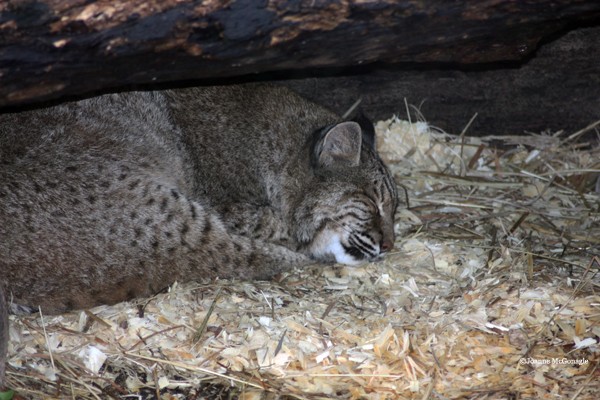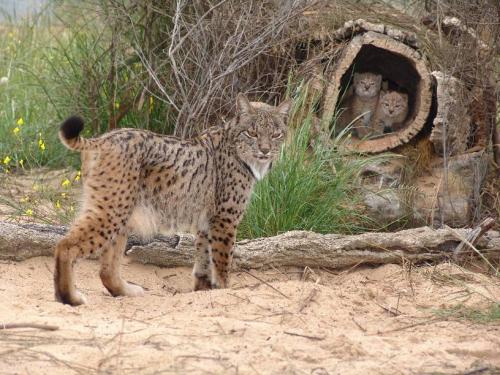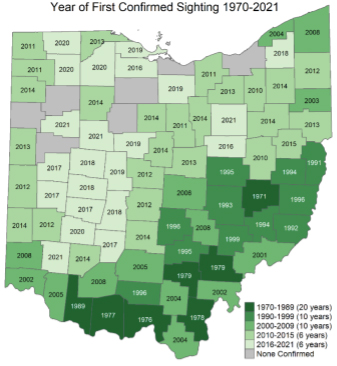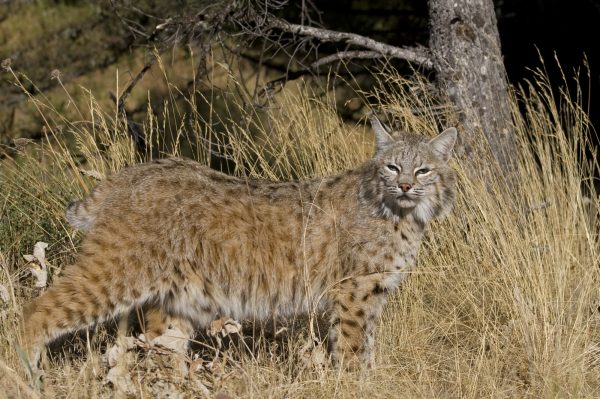
Bobcat Population in Ohio
Bobcats are Native to Ohio
The bobcat is a native species to Ohio and one of seven wild cat species found in North America. They are generally twice the size of an average house cat, with short, dense, soft fur. Bobcat sightings became more frequent in the early 2000s, and a combination of monitoring and research has revealed that Ohio now supports an established bobcat population in the eastern and southern parts of the state, and the population is continuing to expand into other areas of suitable habitat.
Description
Bobcats are small wildcats that typically weigh between 9 and 40 lbs, with males being larger than females. Their coat color varies from light gray, yellowish brown, buff, brown, and reddish brown with black spots on the upper parts of the body. The degree and distinctiveness of spotting varies between individuals. The fur on the middle of the back is frequently darker than that on the sides. Underparts and the inside of the legs are generally white with distinct dark spots or bars. The back of the bobcat’s ears are black on the edges with a white spot in the center and short black tufts at the tips. The bobcat’s tail is short, or “bobbed”, relative to its body length, and has a black band on the upper side of the end of the tail.

Reproduction
Breeding may occur at any time throughout the year, mostly from December through May. The gestation period lasts about 63 days. When available, the female will use an area of rock outcroppings as a natal den. Litters range from 1 to 6 kittens; 2+ is average. The young are fully weaned at eight weeks and they will disperse and begin life on their own in the fall and late winter.
Habitat & Behavior
Bobcats are adaptable to a wide range of ecosystems, if there is adequate prey and cover available. Throughout their range, bobcats are found in conifer and hardwood forests, deserts, swamps, and brushy fields. Cover provided by dense ground vegetation or topography (rock walls, etc.) is important for bobcats to be able to effectively hunt and can also provide protected resting and den sites. Prey availability appears to be a driving factor in habitat selection for bobcats, and high densities of prey will dictate habitat use. Bobcats do make use of human-altered landscapes in rural, suburban, and urban areas, but they avoid areas of intense agriculture, highly developed areas, or areas with a large amount of human activity.
Generally, bobcats are solitary, and interactions with other bobcats are limited to breeding, and females accompanied by dependent young. Adult bobcats establish independent home ranges. A male’s home range may overlap ranges of several females, as well as ranges of other males. Females generally have limited home range overlap with other females. Bobcats are ambush predators and typically lie in wait for their prey, pouncing when an animal comes near, and prey pursuit rarely extends more than 60 feet. They are generalist carnivores and while mammals make up a majority of their diet, they may also consume other prey including insects, reptiles, amphibians, fish, and birds.

Research & Surveys
Bobcat sighting reports have been the primary method used to track bobcat populations since they began to recolonize Ohio. The number of confirmed bobcat sightings reported annually began to steadily increase in the early 2000s. From 1970 to 2021, 4,159 confirmed sightings were documented in 81 Ohio counties. Sightings are most often confirmed through trail camera images or road-killed bobcats. Bobcat sightings are most common in southeast and southern Ohio, where populations are well established. Sightings in northeast Ohio are uncommon and evidence of reproduction has not yet been documented in this part of the state; however, research shows that portions of this area may contain sufficient habitat to support a resident population in the future.
Ohio Bobcat Management Plan
Bobcats have returned to many places in Ohio where they were previously nonexistent, and more Ohioans are viewing them. Recorded data shows that bobcat populations are thriving and expanding in Ohio, with more than 500 confirmed sightings by the Ohio Division of Wildlife annually from 2019 to 2021. Researchers at Ohio University recently concluded a multi-year project to learn more about bobcats in Ohio. Their research indicates that limited harvest regulations could be implemented in Ohio without negatively affecting the long-term viability of the bobcat population. If a season is implemented, it is recommended that conservative harvest limits are used, biological information is collected from the bobcats, and additional monitoring continues.
All this information, and more, is available in the Ohio Bobcat Management Plan.

Frequently Asked Questions
What is the average weight of a bobcat?
The average weight of a bobcat varies depending on the region they are found in. Generally, male bobcats weigh between 16 to 30 pounds, while females weigh between 10 to 20 pounds.
How can you tell the difference between a bobcat and a lynx?
Bobcats and lynx can look similar, but there are some differences. Bobcats have shorter tufts of hair on their ears, while lynx have longer tufts. Lynx also have larger paws with more fur on the bottom to help them walk on snow. Bobcats have a shorter tail with a black tip, while lynx have a longer tail with a black tip and a black band near the end.
What to do if you see a bobcat?
If you see a bobcat, it is important to keep your distance and not approach it. Bobcats are generally not a threat to humans, but it is important to give them space and respect their territory. If the bobcat is in a residential area, it is recommended to make noise to scare it away.
Where do bobcats live in Ohio?
Bobcats can be found throughout Ohio, but they are most commonly found in the southern part of the state. They prefer areas with dense vegetation cover, such as forests, swamps, and wetlands.
How many bobcats are in Ohio?
The exact number of bobcats in Ohio is unknown, but their population has been increasing in recent years. In 2020, the Ohio Department of Natural Resources reported 690 confirmed sightings of bobcats in the state.